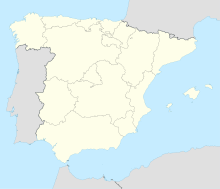Roman Theatre (Tarraco) facts for kids
| Location | Tarragona, Spain |
|---|---|
| Region | Hispania Tarraconensis |
| Coordinates | 41°6′46″N 1°14′58″E / 41.11278°N 1.24944°E |
| Type | Roman theatre |
| History | |
| Cultures | Iberian, Roman |
| Type | Cultural |
| Criteria | ii, iii |
| Designated | 2000 (24th session) |
| Part of | Archaeological Ensemble of Tárraco |
| Reference no. | 875-006 |
| Region | Europe and North America |
| Official name | Yacimiento Arqueológico Teatro Romano |
| Type | Non-movable |
| Criteria | Archaeological site |
| Designated | 5 December 1977 |
| Reference no. | RI-55-0000111 |
The Roman Theatre of Tarraco is an ancient Roman theatre located in Tarragona, Spain. Long ago, this city was a Roman colony called Tarraco, and it was the capital of the Roman province of Hispania Tarraconensis. This theatre was built around the end of the 1st century BC, during the time of Emperor Augustus. It was used for exciting Roman plays and performances.
The theatre was cleverly built into the side of a hill, using the natural slope for some of its seating. Even though parts of it were damaged over time, you can still see the main sections: the cavea (where people sat), the orchestra (the central performance area), and the scaena (the stage). Today, you can visit a special lookout point to see the ruins. This theatre is now part of the Archaeological Ensemble of Tárraco, which was recognized as a World Heritage Site by UNESCO in 2000.
Contents
A Look Back: The Theatre's Story
The Roman Theatre of Tarraco was built around 2,000 years ago, at the end of the 1st century BC. It was part of a big plan by Emperor Augustus to make the city's forum more impressive. This made the theatre one of the most important buildings in Tarraco.
The theatre was used for plays and shows until the end of the 2nd century AD. After that, it stopped being a theatre and was used for other things. In the 3rd century, after a fire, new buildings were constructed nearby. Workers used materials from the old theatre to build these new structures.
How the Theatre Was Built and Used
Today, the theatre is still being cared for and restored. A special viewing spot has been opened on Sant Magí street. Work is ongoing to bring the theatre space and nearby buildings back to life.
Clever Design and Seating
To build the theatre, the Romans used the natural slope of the land. This was similar to how the Amphitheater in the same city was built. They carved out some of the seating area directly from the hillside. For the rest of the seating, they used a system of circular hallways called cryptoporticus.
The Stage Area
The scaena was a very important part of the Roman theatre. This was the stage area where all the plays happened. It was raised up on a platform, often decorated with special curved spaces called exedras.
Next to the stage, there was a special entrance area for people coming to watch the shows. This area was made beautiful with gardens and even had a pond with statues.
The front of the stage, called the proscaenium, was enclosed and had many detailed decorations. This decorated front was known as the frons scaenae.
Audience Seating
The way people sat in the Roman theatre was very organized. It depended on their social status and wealth. Important people sat closer to the stage, while others sat further back.
What Remains and What We've Found
Today, you can still see the first five rows of seats around the orchestra area. Also, two of the three staircases that divided the seating sections are still there. The foundations of the stage platform (the pulpitum) and the decorated stage front (the scaenae frons) are also visible. You can even see where the supports for the stage curtain used to be.
Archaeologists have dug up many interesting things in and around the theatre. They have found beautiful capitals (the tops of columns), friezes (decorated bands), parts of columns, and even sculptures. These finds help us understand what the theatre looked like long ago.
See also
 In Spanish: Teatro romano de Tarraco para niños
In Spanish: Teatro romano de Tarraco para niños
- List of Roman theatres
- Tarragona Amphitheatre
- Wall of Tarragona
- Devil's Bridge
- Tower of the Scipios
- Tarraco
References


